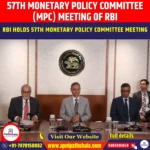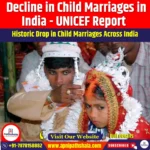Decline in Child Marriages in India – UNICEF Report
|
General Studies Paper II: Issues Related to Women, Government policies and interventions |
Why in News?
Recently, UNICEF released a report in September 2025 highlighting a significant decline in child marriages across India. The report shows that continuous awareness campaigns and government welfare schemes have created positive change to a steady reduction in underage marriages nationwide.
UNICEF Report on Decline in Child Marriages in India Highlights
-
- Title: The UNICEF Report is titled “Tipping Point to Zero: Evidence Towards a Child Marriage Free India.”
- Release: The report was unveiled during a side event at the United Nations General Assembly in New York in September 2025. It reflects India’s progress towards achieving the Sustainable Development Goal 5 on gender equality.
- Conduct of the Study: The study was carried out by Just Rights for Children (JRC), which is a network of more than 250 child protection organisations. The research was conducted between 2022 and 2024 in five states with the support of the Government of India, UNICEF, and other civil society partners. The study covered 757 villages using multistage stratified random sampling.
- National-Level Findings: According to the report, child marriage among girls declined by 69% while child marriage among boys dropped by 72% in recent years. This scale of reduction was unimaginable even a decade ago. Awareness of laws has spread widely, with 99% of respondents stating they had heard about the Bal Vivah Mukt Bharat Campaign. Persistent factors such as poverty, traditions, and concerns about the safety or purity of girls continue to pressure families into marrying off children early.
- State-Wise Data:
-
-
- Assam recorded the highest fall, with 84% decline in child marriages of girls. Engagement of boys and men in campaigns helped shift community attitudes in the state.
- Maharashtra and Bihar each reported around 70% reduction. However, education indicators revealed disparities, with Bihar showing only 9% villages where all girls in the 6–18 age group were attending school, compared to 51% in Maharashtra.
- Rajasthan, once labelled as a hotspot for child marriages, achieved a decline of 66% among girls and 67% among boys. Here, awareness campaigns were considered the strongest factor in change, with 99% of respondents rating them as effective.
- Karnataka showed a 55% fall, reflecting positive results but also the need for more focused work.
- Andhra Pradesh witnessed a drop from 33% (NFHS-4) to 29.3% (NFHS-5). Rajasthan’s NFHS data also confirmed a fall from 35.4% to 25.4% between the two survey rounds.
-
- Drivers Behind Decline: The report points out several drivers for this reduction:
- Awareness campaigns were rated the most powerful, with 99% respondents in Rajasthan considering them critical.
- Law enforcement had a visible effect, with 82% respondents citing arrests and prosecutions as a deterrent.
- Community involvement in programs such as “Child Marriage Free Villages” in Odisha created ownership and sustainability.
- Schooling for girls in many villages increased significantly, with some recording full attendance for ages 6–18 years.
- Education continues to be a crucial tool in reducing child marriage. The report notes that in 31% of villages studied, all girls were in school.
- Assam pioneered models where boys and men actively promoted gender equality.
- Chhattisgarh’s Jashpur district saw success through the “Jay-HO” volunteer campaign, where multiple sectors worked together.
- Odisha scaled up the Child Marriage Free Village initiative, with over 12,400 villages declaring themselves free of the practice by 2022.
- Barriers: The report highlights that poverty remains the strongest driver, cited by 91% of respondents, pushing families to marry off children early. Other major reasons include traditional beliefs (45%), the idea of preserving a girl’s “purity” (45%), and concerns about safety. In education, barriers such as lack of infrastructure (47%), safety issues (42%), and poor transport facilities (24%) keep many girls out of school.
- Recommendations: The study recommends stricter enforcement of child marriage laws and compulsory registration of all marriages to block underage unions.
- It calls for stronger reporting mechanisms, especially at the village level through the Bal Vivah Mukt Bharat portal.
- It also urges for declaring a National Day Against Child Marriage to mobilise collective action.
Legal and Policy Measures Against Child Marriage in India
- Legislations: India enacted the Prohibition of Child Marriage Act, 2006 (PCMA) which sets the legal age of marriage at 18 years for women and 21 years for men. This law prohibits child marriages and empowers authorities to intervene, prevent, and prosecute violations. The Protection of Children from Sexual Offences Act, 2012 (POCSO) also safeguards minors from abuse linked to early marriages.
- Prohibition Officers: Under Section 16 of the PCMA, state governments appoint Child Marriage Prohibition Officers (CMPOs). They prevent child marriages, collect evidence for prosecution, and counsel families. They also create awareness in communities and work closely with panchayats to discourage the practice.
- Commissions: The National Commission for Protection of Child Rights (NCPCR) monitors child rights violations including early marriages. It carries out awareness drives, research, and policy advocacy. Parliamentary committees also review marriage laws and recommend reforms to strengthen protections for children.
- National Action Plan: The National Action Plan to Prevent Child Marriage serves as a comprehensive roadmap. It focuses on identifying girls at risk, providing support services, and building strong monitoring systems at the village and district level.
- Campaigns: The Bal Vivah Mukt Bharat Campaign spreads awareness about the harms of early marriage and advocates a uniform minimum marriage age of 18 years without exceptions. In Karnataka, nearly 90,000 gram panchayat members have been trained to educate families and communities.
|
United Nations Children’s Fund (UNICEF)
|
|
Also Read: Global Child Labour Report 2024 |








